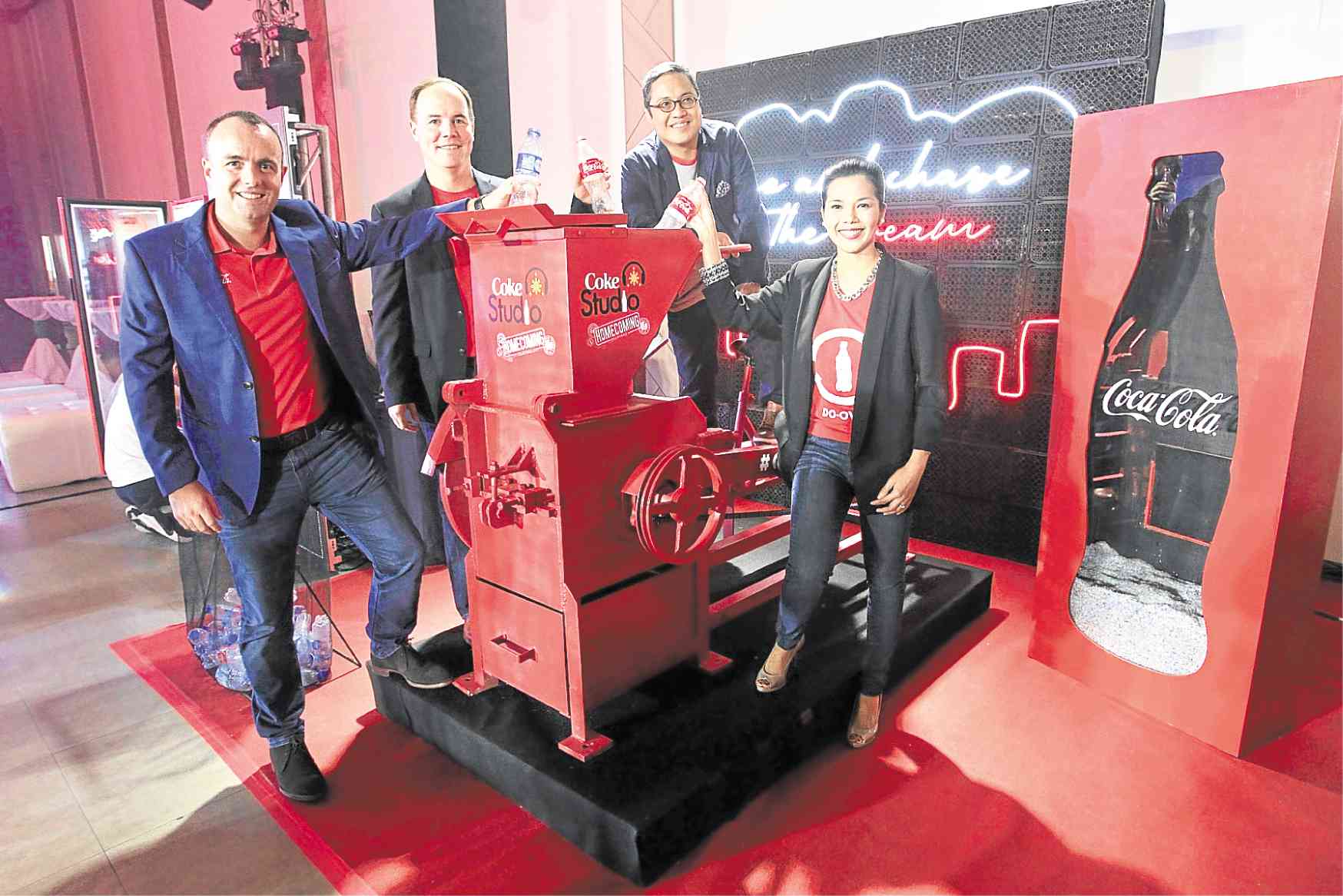
The Coca-Cola System in the Philippines is instituting their green activation module that ensures that they collect and recycle every bottle they put out in the market. All green activations are in partnership with the barangay and the city government’s environmental officers and waste collectors. (From left) Leading the charge are Coca-Cola Beverages Philippines Inc. president and CEO, Gareth McGeown; Coca-Cola Philippines president and general manager, Winn Everhart; Coca-Cola Beverages Philippines Inc. director for corporate and regulatory affairs, Juan Lorenzo Tañada; and Coca-Cola Philippines public affairs and communications director Jonah de Lumen-Pernia. —CONTRIBUTED PHOTO
A man stood on the stage with an ambitious goal, but not much of a fleshed out plan. He wore a shirt so red, that if not for his coat and blue jeans, he would have blended in with the red light of the LED screen behind him.
It took five recycled plastic bottles to make the shirt he wore that day. And for Winn Everhart, president and general manager of Coca-Cola Philippines, his red shirt was not just a piece of clothing, but more of a business proposal.
By 2030, the beverage company, beloved by Filipinos across generations, aims to collect and recycle a bottle or can for each one they sell. Then, by that year, it aims to use at least half of the recycled content in its packaging.
This is part of the company’s global vision called a “World Without Waste.” On June 11, Coca-Cola Philippines launched the road map in Metro Manila, announcing a P1-billion recycling plant that will help make this vision a reality.
In a candid moment during the launch, Everhart said that their goal was “truly ambitious, and to be honest, so much scary.”
“In fact, I can honestly say we don’t know exactly how we’re going to do it, or we don’t really have all the answers,” he said.
“A problem with this size and scale requires bringing people together from government, companies and NGOs (nongovernmental organizations). We’re even working with some of our competitors towards finding a solution to the plastic waste problem,” he added.
Oceans of plastic
The Philippines is one of five countries responsible for about half of the global plastic waste that ends up in the oceans, according to a UN report in 2018.
Rapid economic growth comes with more consumption, which, in turn, comes with more plastic goods used. The case is the same for four other countries—China, Indonesia, Thailand and Vietnam.
If the current trends continue, the oceans, the report read, could have more plastic than fish by 2050. It is not clear how much of this plastic waste are plastic bottles.
Coca-Cola, which has been in the Philippines for more than a hundred years, is part of the country’s growth story, and in a way, also responsible for the increase in plastic waste.
This is despite the company’s efforts to go green, such as selling half of its Coke bottles in reusable glass bottles, a move which reduces the amount of plastic Coca-Cola produces. The majority of collected plastic bottles are exported to China.
But the recycling plant will help solve the problem. In 2020, it will become operational with a capacity to recycle 16,000 metric tons of plastic waste, which could be turned into reusable bottles, and among others, shirts.
Finer details about the investment, however, are still under negotiation, according to Gareth McGeown, president of Coca-Cola Beverages Philippines Inc. (CCBPI), the company’s bottling arm.
‘It’s not about the investment’
After the launch, McGeown told reporters that CCBPI was still in talks with local and international partners, the names of which he could not yet disclose.
He did not say how much of the P1-billion cost will be shouldered by Coca-Cola, although he did say that their share will be “significant,” marking the brand’s first major investment in a recycling facility in Southeast Asia.
Everhart, however, said that their biggest concern was not the investment but the collection strategy. That, he said, is where the country could “truly unlock the value of recycling.”
“If you look at the recycling process in the Philippines, it’s not about the technology we’re using to invest in the equipment. It’s about making sure we have the right collection partner and collection strategy,” he said.
McGeown said they were scouting for possible locations, somewhere within 100 kilometers of the Greater Manila Area. The company hopes to break ground for the plant before the end of the year.
“This is our initial investment, so our intention will be to over time continue to grow, so we need a site bigger than the initial footprint to enable us to increase the potential,” he said.
The recycling facility will collect, sort, clean and wash postconsumer recyclable plastic bottles and turn them into new bottles using advanced technology, thus bringing it rightly back into the value chain, Coca-Cola’s press statement read.
McGeown said that the plant would accept plastic wastes from their competitors, too, explaining that their “overall goal is to do the right thing.”
A World Without Waste
“But to enable this to work in the long run, it needs to be self-funding. So, the intent is over time, maybe not for the first couple of years, but over time, it will become a sustainable and profitable business that allows us to continue and invest and expand,” he said.
The company still has more than a decade to go before the it reaches its self-imposed deadline. But Coca-Cola is already optimistic about it.
During the launch, McGeown, who has been in the Philippines for seven years, talked about how proud he was of project, even though the facility is not even up yet.
“This investment is one of the ways we are stepping up to be part of the solution for the long haul. I’m with Coca-Cola [for] 17 years, and for me, this feels like the most impactful thing we’ve done,” he said.

